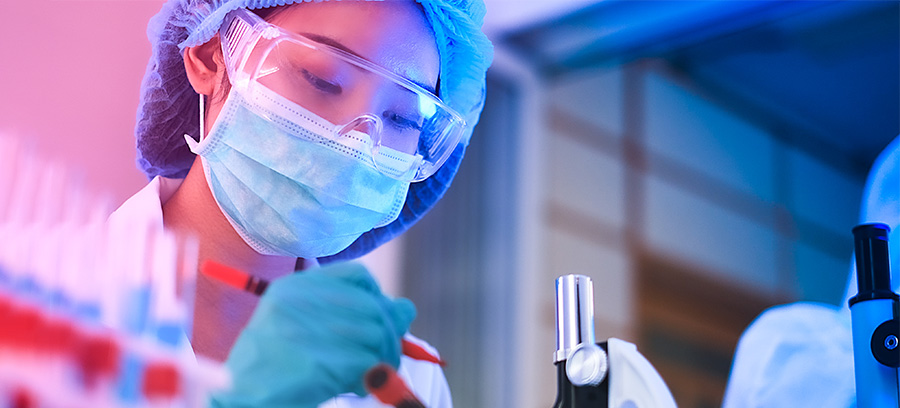Real-Time Polymerase Chain Reaction (real-time PCR) has revolutionized the diagnosis and management of infectious diseases in acute care settings. Through the coupling of the amplification and direct detection of target microbial DNA in a single reaction vessel, real-time PCR drastically reduces the need for microbial culture methods, decreases wait times required for pathogen detection, and allows clinicians to perform early targeted therapeutic interventions[1].
How Real-Time PCR Works
PCR amplifies short regions of DNA in vitro using an enzymatically-driven process. It relies on knowing partial sequences of DNA for microbes and developing oligonucleotide primers that hybridize specifically to these target sequences. The PCR method uses multiple cycles of heating and cooling to perform rounds of target DNA denaturation, primer hybridization, and primer extension using a thermostable DNA polymerase enzyme. As a result, the target DNA is amplified exponentially, potentially generating billions of copies of target DNA from a single copy in less than an hour[1]. Technological advances to this breakthrough process have allowed increased sensitivity and specificity of detection through double amplification, simultaneous detection of target sequences through multiplex PCR, and evaluation of RNA viruses through reverse transcriptase PCR (RT-PCR) which involves the conversion of RNA into complimentary copies of DNA before amplification[1]. The most significant of these improvements is real-time PCR, in which amplification and detection of target microbial DNA are carried out concurrently, providing speed, simplicity, and reproducibility to the entire process.
Real-Time PCR Use in Infectious Diseases
Real-time PCR is an indispensable tool used by infectious disease specialists due to its sensitivity, specificity, and fast turnaround times for pathogen detection, especially for organisms that cannot be grown in vitro or those with prolonged culture procedures that delay timely diagnoses. For example, detection through real-time PCR of Mycobacterium tuberculosis, a fastidious organism notorious for being slow-growing and difficult to culture[2], has revolutionized tuberculosis diagnosis and treatment programs worldwide with results released within two hours as compared to culture-based methods which takes weeks before results are released[3]. Moreover, resistance to antimicrobial agents can be detected through real-time PCR, as in the case of the detection of mutations in the rpoB gene heralding resistance of tuberculosis strains to rifampicin, an extremely effective first-line anti-TB drug[4]. The use of real-time PCR to rapidly detect antimicrobial-resistant strains of pathogens such as Pseudomonas aeruginosa[5], Helicobacter pylori[6], and Mycoplasma pneumoniae[7] is increasingly becoming crucial for infectious disease specialists managing high-acuity patients in emergency departments and intensive care units and aiding in the delivery of targeted pharmaceutical interventions.
Finally, real-time PCR has also been used to accurately identify previously-unknown virulent pathogens. A real-time reverse transcription PCR (RT-PCR) assay of samples from severe pneumonia patients were instrumental in the detection and isolation of a novel coronavirus in 2019, which we now know as SARS-CoV-2, the etiologic agent of the COVID-19 pandemic[8]. Real-time PCR assays have also been successfully used to identify SARS-CoV-2 variants, targeting the specific spike gene mutations of the Alpha, Beta, Delta, Gamma, and Omicron variants with near-identical results to the more costly and technologically-complex method of whole genome sequencing[9]. Indeed, even with the wealth of diagnostic tools that have been developed to rapidly identify and detect the SARS-CoV-2, real-time PCR testing remains to be the preferred initial diagnostic test for patients suspected of having COVID-19[10] due to its high accuracy and quick time-to-diagnosis.
Jant Pharmacal offers lyophilized multiplex COVID-19 molecular tests, RT-PCR and extraction instrumentation and reagents, swabs and media, as well as other resources for successful SARS-CoV-2 detection. View the selection of available products.
Conclusion
Real-time PCR testing has proven time and again to be a powerful tool to have among the arsenal of infectious disease specialists and front-line physicians. It provides quick-but-accurate diagnoses that allows rapid triaging of patients; provides information on antimicrobial resistance and ensures early targeted antimicrobial therapy; and reduces repetitive testing and waiting times which provides substantial benefits to patients and healthcare providers alike.
References
- Yang S, Rothman RE. PCR-based diagnostics for infectious diseases: uses, limitations, and future applications in acute-care settings. Lancet Infect Dis. 2004;4(6):337-348. doi:10.1016/S1473-3099(04)01044-8
- Ghodbane R, Raoult D, Drancourt M. Dramatic reduction of culture time of Mycobacterium tuberculosis. Sci Rep. 2014;4:4236. Published 2014 Feb 28. doi:10.1038/srep04236
- Zijenah LS, Bandason T, Gwambiwa B, et al. Integration of point-of-care Xpert MTB/RIF and smear microscopy for TB diagnosis with point-of-care HIV tests, CD4 counts and treatment at a primary health care clinic in Harare, Zimbabwe. South African Respiratory Journal. 2014;20:104-111
- Hameed S, Moganeradj K, Mahmood N, McHugh TD, Chaudhry MN, Arnold C. Sequence analysis of the rifampicin resistance determining region (RRDR) of rpoB gene in multidrug resistance confirmed and newly diagnosed tuberculosis patients of Punjab, Pakistan. PLoS One. 2017;12(8):e0183363. Published 2017 Aug 17. doi:10.1371/journal.pone.0183363
- Madden DE, Olagoke O, Baird T, et al. Express Yourself: Quantitative Real-Time PCR Assays for Rapid Chromosomal Antimicrobial Resistance Detection in Pseudomonas aeruginosa. Antimicrob Agents Chemother. 2022;66(5):e0020422. doi:10.1128/aac.00204-22
- Zhao Y, Li Y, Luan Z, et al. Establishment of a TaqMan-MGB probe multiplex real-time PCR system for one-step levofloxacin and clarithromycin resistant Helicobacter pylori detection. J Microbiol Methods. 2022;192:106393. doi:10.1016/j.mimet.2021.106393
- Wang A, Wu Z, Huang Y, et al. A 3D-Printed Microfluidic Device for qPCR Detection of Macrolide-Resistant Mutations of Mycoplasma pneumoniae. Biosensors (Basel). 2021;11(11):427. Published 2021 Oct 29. doi:10.3390/bios11110427
- Zhu N, for the China Novel Coronavirus Investigating and Research Team, et al. A novel coronavirus from patients with pneumonia in China, 2019: Nejm. New England Journal of Medicine. https://www.nejm.org/doi/10.1056/NEJMoa2001017. Published February 20, 2020.
- Borillo GA, Kagan RM, Marlowe EM. Rapid and Accurate Identification of SARS-CoV-2 Variants Using Real Time PCR Assays. Front Cell Infect Microbiol. 2022;12:894613. Published 2022 May 10. doi:10.3389/fcimb.2022.894613
- Fang FC, Naccache SN, Greninger AL. The Laboratory Diagnosis of Coronavirus Disease 2019- Frequently Asked Questions. Clin Infect Dis. 2020;71(11):2996-3001. doi:10.1093/cid/ciaa742


